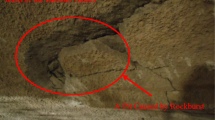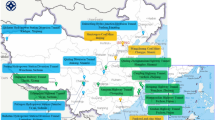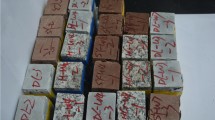Abstract
As a common disaster in deep-buried hard rock engineering projects, rock-bursts seriously threaten the safety of workers and facilities. Water infusion in rock mass before excavation is usually used for rock-burst prevention. To reveal the underlying mechanism of rock watering for rock-burst inhibition, a series of uniaxial compression tests were carried out on sandstone samples with different water contents. The effects of water content on energy evolution characteristics (i.e., energy partition and energy release) were analyzed during loading process. In addition, a new rock-burst proneness criterion in terms of the release rate of post-peak energy was proposed to effectively evaluate the rock-burst proneness of water-bearing sandstone. The rock-burst proneness of samples with various water contents was calculated and compared. The experimental results have shown that with the increase of water content, the pre-peak strain energy density, elastic energy density, and dissipated energy density are decreased to some extents, as well as the rock-burst proneness. The water-induced reductions of the pre-peak elastic energy and the energy release rate during the post-peak phase collectively result in the decrease of rock-burst proneness of water-bearing sandstone.
Highlights
-
Water content significantly affects the energy partition and release of sandstone samples during uniaxial compression.
-
A new rock-burst criterion based on energy release rate is proposed to evaluate the rock-burst potential of water-bearing sandstone samples.
-
The rock-burst proneness of sandstone sample is gradually decreased as water content rises.
-
The water-induced reduction of the elastic energy storage at pre-peak and the energy release rate at post-peak collectively lead to the declining rock-burst proneness of water-bearing sandstone.














Similar content being viewed by others
Data availability
The data supporting the findings of this study are available when the readers request.
Abbreviations
- σ c :
-
Peak stress
- ε c :
-
Peak strain
- σ r :
-
Residual stress
- ε r :
-
Residual strain
- σ bf :
-
Burst failure stress
- E 0 :
-
Young’s modulus
- E u :
-
Unloading modulus
- U o i :
-
Strain energy density under σi stress level
- U e i :
-
Elastic energy density under σi stress level
- U d i :
-
Dissipated energy density under σi stress level
- U o :
-
Pre-peak strain energy density
- U e :
-
Pre-peak elastic energy density
- U d :
-
Pre-peak dissipated energy density
- U a :
-
Post-peak input energy density
- U f :
-
Fracture energy density
- U r :
-
Residual elastic energy density
- \(U_{{{\text{ET}}}}^{{\text{e}}}\) :
-
Elastic energy density at the 0.8σc stress level
- \(U_{{{\text{ET}}}}^{{\text{d}}}\) :
-
Dissipated energy density at the 0.8σc stress level
- A CF :
-
Energy impact index
- \(A^{\prime}_{{{\text{CF}}}}\) :
-
Peak-strength energy impact index
- PES:
-
Elastic potential energy index
- A EF :
-
Residual elastic energy index
- W ET :
-
Strain energy storage index
- V ER :
-
Energy release rate
- T R :
-
Failure time
References
Akdag S, Karakus M, Taheri A et al (2018) Effects of thermal damage on strain burst mechanism for brittle rocks under true-triaxial loading conditions. Rock Mech Rock Eng 51:1657–1682. https://doi.org/10.1007/s00603-018-1415-3
Akdag S, Karakus M, Nguyen GD et al (2021) Evaluation of the propensity of strain burst in brittle granite based on post-peak energy analysis. Undergr Space 6:1–11. https://doi.org/10.1016/j.undsp.2019.08.002
Bieniawski ZT, Denkhaus HG, Vogler UW (1969) Failure of fractured rock. Int J Rock Mech Min Sci Geomech Abstr 6:323–330. https://doi.org/10.1016/0148-9062(69)90009-6
Bruning T, Karakus M, Akdag S et al (2018) Influence of deviatoric stress on rockburst occurrence: an experimental study. Int J Min Sci Technol 28:763–766. https://doi.org/10.1016/j.ijmst.2018.08.005
Cai X, Zhou Z, Liu K et al (2019) Water-weakening effects on the mechanical behavior of different rock types: phenomena and mechanisms. Appl Sci Basel 9:4450. https://doi.org/10.3390/app9204450
Cai M, Hou PY, Zhang XW, Feng XT (2021a) Post-peak Stress-Strain curves of brittle hard rocks under axial-strain-controlled loading. Int J Rock Mech Min Sci 147:104921. https://doi.org/10.1016/j.ijrmms.2021.104921
Cai X, Cheng C, Zhou Z et al (2021b) Rock mass watering for rock-burst prevention: some thoughts on the mechanisms deduced from laboratory results. Bull Eng Geol Environ 80:8725–8743. https://doi.org/10.1007/s10064-021-02467-0
Chen G, Li T, Guo F, Wang Y (2017) Brittle mechanical characteristics of hard rock exposed to moisture. Bull Eng Geol Environ 76:219–230. https://doi.org/10.1007/s10064-016-0857-7
Chen J, Ye Y, Pu Y et al (2022) Experimental study on uniaxial compression failure modes and acoustic emission characteristics of fissured sandstone under water saturation. Theor Appl Fract Mech 119:103359. https://doi.org/10.1016/j.tafmec.2022.103359
Dyke CG, Dobereiner L (1991) Evaluating the strength and deformability of sandstones. Q J Eng Geol Hydroge 24:123-134
Feng X-T, Liu J, Chen B et al (2017) Monitoring, warning, and control of rockburst in deep metal mines. Engineering 3:538–545. https://doi.org/10.1016/J.ENG.2017.04.013
Freiman SW (1984) Effects of chemical environments on slow crack growth in glasses and ceramics. J Geophys Res Atmos 89:4072–4076. https://doi.org/10.1029/JB089iB06p04072
Frid V (2000) Electromagnetic radiation method water-infusion control in rockburst-prone strata. J Appl Geophys 43:5–13. https://doi.org/10.1016/S0926-9851(99)00029-4
GB/T 25217.2 (2010) Methods for measurement, monitoring and control of rock burst (Part 2): Classification and index determination of coal burst liability
Gong F, Yan J, Li X (2018) A new criterion of rockburst proneness based on the linear energy storage law and the residual elastic energy index. Chin J Rock Mech Eng 37:1993–2014
Gong F, Wang Y, Luo S (2020) Rockburst proneness criteria for rock materials: review and new insights. J Cent South Univ 27:2793–2821. https://doi.org/10.1007/s11771-020-4511-y
Gong F, Wang Y, Wang Z et al (2021) A new criterion of coal burst proneness based on the residual elastic energy index. Int J Min Sci Technol 31:553–563. https://doi.org/10.1016/j.ijmst.2021.04.001
Huang D, Li Y (2014) Conversion of strain energy in triaxial unloading tests on marble. Int J Rock Mech Min Sci 66:160–168. https://doi.org/10.1016/j.ijrmms.2013.12.001
ISRM (1979) Suggested methods for determining the uniaxial compressive strength and deformability of rock materials. Int J Rock Mech Min Sci Geomech Abstr 2:135–140
Kawai K, Sakuma H, Katayama I, Tamura K (2015) Frictional characteristics of single and polycrystalline muscovite and influence of fluid chemistry. J Geophys Res Solid Earth 120:6209–6218. https://doi.org/10.1002/2015JB012286
Kidybiński A (1981) Bursting liability indices of coal. Int J Rock Mech Min Sci Geomech Abstr 18:295–304. https://doi.org/10.1016/0148-9062(81)91194-3
Klein E, Reuschlé T (2004) A pore crack model for the mechanical behaviour of porous granular rocks in the brittle deformation regime. Int J Rock Mech Min Sci 41:975–986. https://doi.org/10.1016/j.ijrmms.2004.03.003
Kumar R, Sharma KG, Varadarajan A (2010) Post-peak response of some metamorphic rocks of India under high confining pressures. Int J Rock Mech Min Sci 47:1357–1362. https://doi.org/10.1016/j.ijrmms.2010.08.016
Li Y (1985) Mechanism of rock burst and its preliminary application. J China Inst Min Technol 42–48
Li S (2001) Experimental study on dynamic failure of rockburst propensity. J China Liaoning Tech Univ 20:436–438
Li X, Gong F, Tao M et al (2017) Failure mechanism and coupled static-dynamic loading theory in deep hard rock mining: a review. J Rock Mech Geotech Eng 9:767–782. https://doi.org/10.1016/j.jrmge.2017.04.004
Li H, He M, Shen R et al (2021a) Acoustic emission waveform analysis of sandstone failure with different water content. Geofluids 2021:5290076. https://doi.org/10.1155/2021/5290076
Li H, Qiao Y, Shen R et al (2021b) Effect of water on mechanical behavior and acoustic emission response of sandstone during loading process: phenomenon and mechanism. Eng Geol 294:106386. https://doi.org/10.1016/j.enggeo.2021.106386
Liu X, Liang Z, Zhang Y et al (2018) Experimental study on the monitoring of rockburst in tunnels under dry and saturated conditions using AE and infrared monitoring. Tunn Undergr Space Technol 82:517–528. https://doi.org/10.1016/j.tust.2018.08.011
Liu W, Yan E, Dai H et al (2020) Study on characteristic intensity and energy evolution of mudstone water action in Badong Formation. Chin J Rock Mech Eng 39:311–326
Lu Z, Ju W, Gao F et al (2019) A new bursting liability evaluation index for coal—the effective elastic strain energy release rate. Energies 12:3734. https://doi.org/10.3390/en12193734
Luo Y (2020) Influence of water on mechanical behavior of surrounding rock in hard-rock tunnels: an experimental simulation. Eng Geol 277:105816. https://doi.org/10.1016/j.enggeo.2020.105816
Luo D, Xie Y, Lu S, Su G (2022) Experimental study on the effects of water saturation on the microseismic and acoustic emission characteristics of sandstone in different stress states. Rock Mech Rock Eng 55:6583–6603. https://doi.org/10.1007/s00603-022-03001-8
Manouchehrian A, Cai M (2018) Numerical modeling of rockburst near fault zones in deep tunnels. Tunn Undergr Space Technol 80:164–180. https://doi.org/10.1016/j.tust.2018.06.015
Michalske T et al (1982) A molecular interpretation of stress corrosion in silica. Nature 295:511–512. https://doi.org/10.1038/295511a0
Moore D, Lockner D (2004) Crystallographic controls on the frictional behavior of dry and water-saturated sheet structure minerals. J Geophys Res. https://doi.org/10.1029/2003JB002582
Morrow CA, Moore DE, Lockner DA (2000) The effect of mineral bond strength and adsorbed water on fault gouge frictional strength. Geophys Res Lett 27:815–818. https://doi.org/10.1029/1999GL008401
MT/T 174 (2000) Coal seam bursting liability classification and index determination method
Munoz H, Taheri A, Chanda EK (2016a) Rock drilling performance evaluation by an energy dissipation based rock brittleness index. Rock Mech Rock Eng 49:3343–3355. https://doi.org/10.1007/s00603-016-0986-0
Munoz H, Taheri A, Chanda EK (2016b) Fracture energy-based brittleness index development and brittleness quantification by pre-peak strength parameters in rock uniaxial compression. Rock Mech Rock Eng 49:4587–4606. https://doi.org/10.1007/s00603-016-1071-4
Saadat M, Taheri A (2019) Modelling micro-cracking behaviour of pre-cracked granite using grain-based distinct element model. Rock Mech Rock Eng 52:4669–4692. https://doi.org/10.1007/s00603-019-01862-0
Shirani Faradonbeh R, Taheri A, Ribeiro e Sousa L, Karakus M (2020) Rockburst assessment in deep geotechnical conditions using true-triaxial tests and data-driven approaches. Int J Rock Mech Min Sci 128:104279. https://doi.org/10.1016/j.ijrmms.2020.104279
Singh SP (1987) The influence of rock properties on the occurrence and control of rockbursts. Min Sci Technol 5:11–18. https://doi.org/10.1016/S0167-9031(87)90854-1
Sun X, Xu H, Zheng L et al (2016) An experimental investigation on acoustic emission characteristics of sandstone rockburst with different moisture contents. Sci China Technol Sci 59:1549–1558. https://doi.org/10.1007/s11431-016-0181-8
Tajdus A, Cieslik J, Tajdus K (2014) Rockburst hazard assessment in bedded rock mass: laboratory tests of rock samples and numerical calculations. Arch Min Sci 59:591–608. https://doi.org/10.2478/amsc-2014-0042
Tan YA (1992) Discussion on the energy impact index of rockburst. Hydrogeol Eng Geol 19:10–12
Tarasov B, Potvin Y (2013) Universal criteria for rock brittleness estimation under triaxial compression. Int J Rock Mech Min Sci 59:57–69. https://doi.org/10.1016/j.ijrmms.2012.12.011
Tarasov BG, Randolph MF (2011) Superbrittleness of rocks and earthquake activity. Int J Rock Mech Min Sci 48:888–898. https://doi.org/10.1016/j.ijrmms.2011.06.013
Tutluoğlu L, Öge İF, Karpuz C (2015) Relationship between pre-failure and post-failure mechanical properties of rock material of different origin. Rock Mech Rock Eng 48:121–141. https://doi.org/10.1007/s00603-014-0549-1
Wang J-A, Park HD (2001) Comprehensive prediction of rockburst based on analysis of strain energy in rocks. Tunn Undergr Space Technol 16:49–57. https://doi.org/10.1016/S0886-7798(01)00030-X
Wang C, He B, Hou X et al (2020) Stress-energy mechanism for rock failure evolution based on damage mechanics in hard rock. Rock Mech Rock Eng 53:1021–1037. https://doi.org/10.1007/s00603-019-01953-y
Wang H, Li J, Guo Q et al (2021) Experimental study on the influence of water on the failure properties of sandstone. Bull Eng Geol Environ 80:7747–7771. https://doi.org/10.1007/s10064-021-02410-3
Xie H, Li L, Peng R, Ju Y (2009) Energy analysis and criteria for structural failure of rocks. J Rock Mech Geotech Eng 1:11–20. https://doi.org/10.3724/SP.J.1235.2009.00011
Yasar S (2020) Long term wetting characteristics and saturation induced strength reduction of some igneous rocks. Environ Earth Sci. https://doi.org/10.1007/s12665-020-09105-0
Zhang X, Feng G, Kang L, Yang S (2009) Method to determine burst tendency of coal rock by residual energy emission speed. J China Coal Soc 34:1165–1168
Zhang Z, Gao F, Shang X (2014) Rock burst proneness prediction by acoustic emission test during rock deformation. J Cent South Univ 21:373–380. https://doi.org/10.1007/s11771-014-1950-3
Zhang Y, Ma J, Sun D et al (2020) AE Characteristics of rockburst tendency for granite influenced by water under uniaxial loading. Front Earth Sci 8:55. https://doi.org/10.3389/feart.2020.00055
Zhang Y, Feng X-T, Yang C et al (2021) Evaluation method of rock brittleness under true triaxial stress states based on pre-peak deformation characteristic and post-peak energy evolution. Rock Mech Rock Eng 54:1277–1291. https://doi.org/10.1007/s00603-020-02330-w
Zhao Y, Yang T, Xu T et al (2018) Mechanical and energy release characteristics of different water-bearing sandstones under uniaxial compression. Int J Damage Mech 27:640–656. https://doi.org/10.1177/1056789517697472
Zhao K, Yang D, Zeng P et al (2021) Effect of water content on the failure pattern and acoustic emission characteristics of red sandstone. Int J Rock Mech Min Sci 142:104709. https://doi.org/10.1016/j.ijrmms.2021.104709
Zhou J, Li X, Mitri HS (2018a) Evaluation method of rockburst: state-of-the-art literature review. Tunn Undergr Space Technol 81:632–659. https://doi.org/10.1016/j.tust.2018.08.029
Zhou Z, Cai X, Ma D et al (2018b) Effects of water content on fracture and mechanical behavior of sandstone with a low clay mineral content. Eng Fract Mech 193:47–65. https://doi.org/10.1016/j.engfracmech.2018.02.028
Zhou Z, Cai X, Li X et al (2020) Dynamic response and energy evolution of sandstone under coupled static-dynamic compression: insights from experimental study into deep rock engineering applications. Rock Mech Rock Eng 53:1305–1331. https://doi.org/10.1007/s00603-019-01980-9
Zhu J, Deng J, Huang Y, He Z (2019) Influence of water on the fracture process of marble with acoustic emission monitoring. Ksce J Civ Eng 23:3239–3249. https://doi.org/10.1007/s12205-019-0172-5
Acknowledgements
The work is supported by the National Natural Science Foundation of China (52104111, 41772313), the Natural Science Foundation of Hunan Province (2021JJ30819, 2020JJ7059), National Key Research and Development Program of China (2022YFC2903901), and Open Fund of State Key Laboratory of Safety Technology of Metal Mines (kfkt2023-01). The authors are very grateful to the financial contribution and convey their appreciation for supporting this basic research.
Author information
Authors and Affiliations
Contributions
ZZ: conceptualization; supervision; funding acquisition; writing-review and editing. PW: methodology; writing-original draft. WC: writing-review and editing. XC: methodology; testing; visualization; writing-review and editing.
Corresponding authors
Ethics declarations
Conflict of interest
We would like to declare that the work described is original research that has not been published previously, and is not under consideration for publication elsewhere, in whole or in part. We declare that we do not have any commercial or associative interest that represents a conflict of interest in connection with the work submitted. The manuscript is approved by all authors for publication.
Additional information
Publisher's Note
Springer Nature remains neutral with regard to jurisdictional claims in published maps and institutional affiliations.
Rights and permissions
Springer Nature or its licensor (e.g. a society or other partner) holds exclusive rights to this article under a publishing agreement with the author(s) or other rightsholder(s); author self-archiving of the accepted manuscript version of this article is solely governed by the terms of such publishing agreement and applicable law.
About this article
Cite this article
Zhou, Z., Wang, P., Cai, X. et al. Influence of Water Content on Energy Partition and Release in Rock Failure: Implications for Water-Weakening on Rock-burst Proneness. Rock Mech Rock Eng 56, 6189–6205 (2023). https://doi.org/10.1007/s00603-023-03379-z
Received:
Accepted:
Published:
Issue Date:
DOI: https://doi.org/10.1007/s00603-023-03379-z




